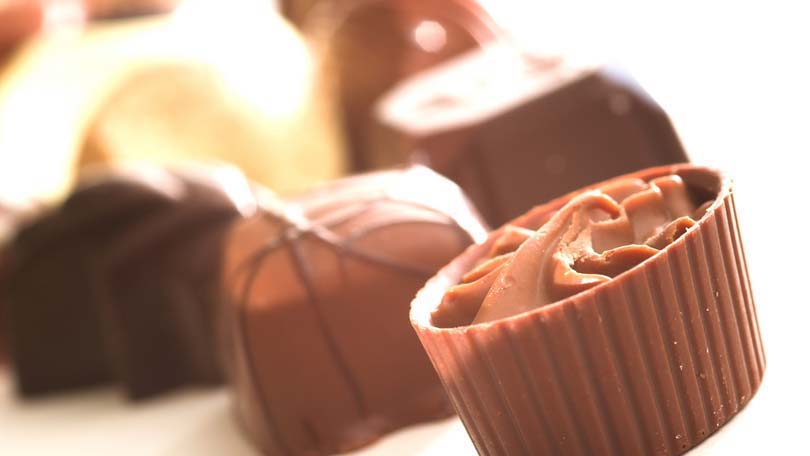Chocolate is made from beans of the cacao tree which is indigenous to the rainforests of the Americas. First cultivated by the Maya and Aztec, the cacao tree was discovered over 2,000 years ago, and the cacao beans were used to make spiced chocolate drinks for important members of society. Spanish conquerors took cacao beans from the Aztecs and brought them back to Europe in the 1500s. Over the next century, chocolate spread throughout Europe, quickly becoming a crowd favorite.
The very first people to discover cacao were the Maya who took the cacao tree from the rainforest and planted it in their backyards to grow and harvest the cacao beans. The Mayans would grind the beans into a paste, and add water, cornmeal, and chile peppers to make a spicy yet bitter chocolate drink. The Maya had no access to sugar, so the first chocolate beverages (known as chocolatl) were not sweet. Around 1400, the Aztecs discovered cacao through trade with the Maya. The Aztecs actually used the cacao beans as a form of currency, demanding that citizens and conquered peoples supply cacao beans as payment. In both Aztec and Maya religious ceremonies priests would offer cacao beans to the gods. Chocolate drinks were served during these religious ceremonies as well. For the Maya, chocolate drinks were consumed by everyone occasionally, but were often consumed by royalty. In Aztec society, mainly rulers, soldiers, and other high status individuals could drink the chocolate beverage.
Spanish conquistadors reached Mexico in approximately 1521 where they observed the consumption of chocolate among the Aztec people. The Spaniards understood the value of the cacao bean and brought it back to Europe with them, making the chocolate beverage for European royalty. When the cacao was shipped back to Europe, the Aztec drink was too bitter for Europeans, so they added sugar cane, vanilla, and even cinnamon, and began heating the chocolate concoction to be enjoyed warm. Cacao beans were an expensive import, so the chocolate drink was a status symbol among the upper class people of Europe who would drink the chocolate out of elaborate porcelain and silver cups. Eventually, cacao beans became available to the rest of Europe when the price of cacao beans dropped, and the hot chocolate beverage became wildly popular.
To keep up with demand for the cacao bean, Spaniards set up colonial plantations using slaves and wage laborers to grow and harvest the cacao and sugar cane. Small European shops would make the beans into chocolate drinks, and eventually one company called Fry & Sons introduced solid chocolate in 1847. Then in 1876, Daniel Peter of Switzerland developed a way to add milk to chocolate, giving the chocolate a sweeter flavor and smoother texture, creating milk chocolate. A steam engine was introduced during the Industrial Revolution of the 1700s which ground large amounts of cacao beans and processed them into solid chocolate. This mass production method made chocolate affordable to the majority of the public for the very first time. As chocolate became more inexpensive, manufacturers began advertising chocolate heavily to women and children. Chocolate for breakfast was encouraged to provide a boost of energy, and many people began to use chocolate in desserts and confections.
Today, most chocolate is processed and manufactured by machinery, but the cacao beans are still farmed and harvested basically the same way as the Aztecs and Maya farmed them – by hand. In 1910, William Cadbury brought together a group of American and English chocolate companies who refused to buy chocolate from cacao plantations with harsh working conditions. Still, some cacao plantations, most of which are found in West Africa, use slave labor when the prices of cacao beans fall.
Chocolate is still related to holidays such as Easter and Christmas, and is enjoyed throughout the world. It is provided as a ration for the United States military who introduced chocolate to Japan during World War 2, and is even used in medicines and cosmetics. Chocolate is continually studied for possible health benefits, and has been found to provide flavonoids and antioxidants that protect the body from disease. Many chocolate companies have come and gone, but a few manufacturers such as Cadbury, Hershey, and Mars remain, all of which began in the late 1800s to early 1900s.
A tale beginning in the depth of the American rainforests over 2000 years ago, the history of chocolate includes religious worship, slavery, high-society snobbery, and a transformation in production methods to make chocolate available to the masses. The same cacao bean that was so highly regarded by the Maya and Aztecs still remains a beloved treat of modern society.






